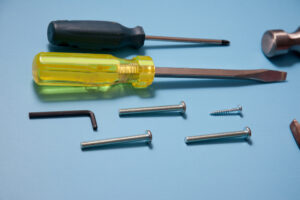Sing it with me, “all my single ladies, now put your hands up!” Ok, now that our dance break is over, it’s time to get serious. I was raised by a single mother, so I am partially biased to the female demographic on this topic. I was not allowed to drive a car until I could check the fluids and change a tire. I also knew the difference between a Phillips head and a flat head screwdriver, and I find it crucial that every woman, and man for that matter, single or not, learn a few basic life skills. So I am here to teach you.
 Phillips Head vs Flathead Screwdriver
Phillips Head vs Flathead Screwdriver
The main difference between a flathead screwdriver and a Phillips screwdriver should be pretty noticeable at first glance. A flathead has a single blade, and a Phillips has two blades in the shape of a cross.
Basic Car Maintenance
Check Fluids
- Engine Oil
- You can usually find the oil dipstick near the front or behind the engine. Start by pulling the dipstick out and wiping it off with a clean paper towel or rag. Then put the dipstick back into the oil and pull it out again. To check the level of your oil, look at the indicator lines on the dipstick. It will show you the maximum and minimum levels required for your car. If the oil mark is near the top level, you are fine, and your oil level is close to full. If the oil mark is near the minimum line, it means your oil level is low, and you need to add oil. This could also indicate that you are burning oil or leaking oil, which can cause significant damage to your engine.
- Also, pay attention to the color of your oil. Typically engine oil is a yellow, amber color when new; if it’s a brown or black shade, it’s time to get your oil changed.
- Coolant or Antifreeze
- Your car’s radiator prevents your engine from freezing or overheating, but only if the coolant level is correct. First, you need to locate your radiator cap; it might also say “cooling system” on top and usually has a warning sign not to open when hot. After opening the lid, it will be obvious if there is fluid or not. There are different shades of coolant, so check your owner’s guide to make sure you have the correct version.
- Windshield Wiper Fluid
- Like coolant, wiper fluid is easy to figure out. The cap is easy to spot under the hood because it will have a windshield wiper on it. The fluid color is often bright, and if your level is empty, fill it up to the top and close the cap.

- Like coolant, wiper fluid is easy to figure out. The cap is easy to spot under the hood because it will have a windshield wiper on it. The fluid color is often bright, and if your level is empty, fill it up to the top and close the cap.
- Transmission Fluid
- For most cars, this process is similar to checking your oil. Start by finding your fill tube if your car has one. Check the level, and then with the car running and the transmission in park or neutral, check your car’s owner manual, pour in the fluid.
- Brake Fluid
- Usually, the brake fluid canister is on the driver’s side near the top of the brake master cylinder. Take off the cap and make sure the brake fluid level is within half an inch of the cap. If the color is black, it’s time to get it replaced. A properly trained mechanic should do this because brake fluid is one of the most toxic fluids in your car.
Emergency Kit
- You can go on Amazon and type in “car emergency kit,” and many options will pop up at various prices.
- The Basics: jumper cables, flashlight with extra batteries, first aid kit, water bottle, car jack, lug wrench
- Extras: change of clothes, blanket, snacks, tool kit, gloves, tire pressure gauge, snow shovel, glass breaker, flare gun, reflective warning triangle
 Changing A Flat Tire
Changing A Flat Tire
- Find a safe location
- If your tire blows out while driving. Keep the wheel steady and steer straight as possible and merge over to the median. If that is not possible, put your hazard lights on immediately. If your tire suddenly has a blowout, do not slam on your brakes. Gently take your foot off the accelerator and gently press on the brakes.
- Turn on your emergency hazard lights
- Apply the parking brake
- This reduces the chance of your car rolling
- Apply wheel wedges if you have them
- Remove the hubcap or wheel cover
- If the lug nuts are exposed, skip this step
- Loosen the lug nuts
- With your lug wrench, turn the lug nuts counterclockwise until they start to loosen up. Do not remove them altogether. Remember righty-tighty, lefty-loosey. You might have to use a lot of force, so it’s ok to use your foot and your body weight
- Put the jack under your car
- The best placement for your jack is usually beneath the vehicle’s frame, close to the flat tire. However, check your owner’s manual just in case.
- Slowly raise your vehicle with the jack
- Unscrew the Lug Nuts
- Now it’s time to remove the lug nuts altogether
- Remove the Flat tire
- Mount your spare tire on the Lug Bolts
- Put the lug nuts back on your tire and tighten as much as possible
- Slowly lower your vehicle so that the spare tire is touching the ground, and tighten the Lug Nuts again
- Lower the vehicle completely and tighten the lug nuts one last time
- Replace the Hubcap if necessary
 Home Maintenance
Home Maintenance
Ceiling fan direction
- Summer = counterclockwise
- Winter= clockwise
Changing a Lightbulb
- Make sure the power is turned off
- Unscrew the old lightbulb out of the socket
- Screw the new lightbulb into the socket
Snake a Drain
- Easy: Drain clog remover
- Can be found at any grocery store, or hardware store
- With a Snake
- Push the end of the snake into the drain opening until you reach the clog
- Rotate the snake against the clog until you feel the pipe empty
- Run water on full force for a few minutes to check the drain is unclogged
How to Find a Stud in the Wall
- General rule of thumb. A stud is usually every 16 inches on center, however some are placed every 24.
- Start with a power outlet or light switch then measure from there.
- Tap on the wall
- If you hear an empty or hollow sound, tap a little to the right or left. When you hear a muffled sound, you’ve found the stud
- Buy a stud finder
Ladies, don’t wait around for prince charming; come to your rescue. Hopefully, a few of these tips helped. Comment down below and let me know your essential tips and tricks for being a single lady.


 Phillips Head vs Flathead Screwdriver
Phillips Head vs Flathead Screwdriver
 Changing A Flat Tire
Changing A Flat Tire Home Maintenance
Home Maintenance
